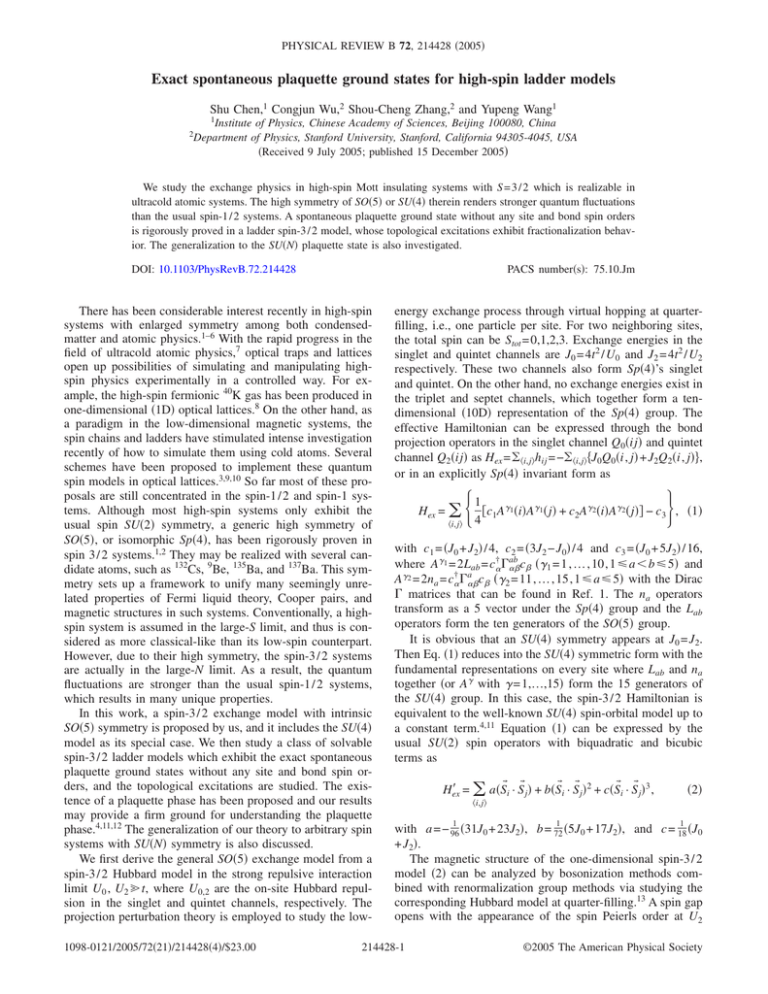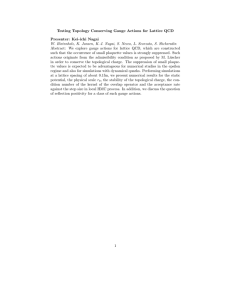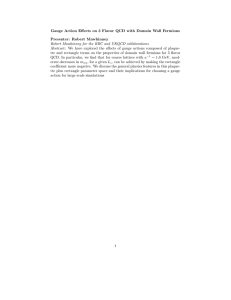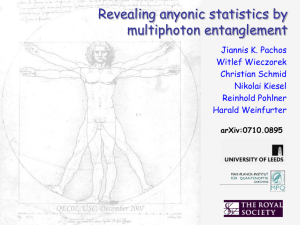Exact spontaneous plaquette ground states for high-spin ladder models
advertisement

PHYSICAL REVIEW B 72, 214428 共2005兲 Exact spontaneous plaquette ground states for high-spin ladder models Shu Chen,1 Congjun Wu,2 Shou-Cheng Zhang,2 and Yupeng Wang1 1Institute 2Department of Physics, Chinese Academy of Sciences, Beijing 100080, China of Physics, Stanford University, Stanford, California 94305-4045, USA 共Received 9 July 2005; published 15 December 2005兲 We study the exchange physics in high-spin Mott insulating systems with S = 3 / 2 which is realizable in ultracold atomic systems. The high symmetry of SO共5兲 or SU共4兲 therein renders stronger quantum fluctuations than the usual spin-1 / 2 systems. A spontaneous plaquette ground state without any site and bond spin orders is rigorously proved in a ladder spin-3 / 2 model, whose topological excitations exhibit fractionalization behavior. The generalization to the SU共N兲 plaquette state is also investigated. DOI: 10.1103/PhysRevB.72.214428 PACS number共s兲: 75.10.Jm There has been considerable interest recently in high-spin systems with enlarged symmetry among both condensedmatter and atomic physics.1–6 With the rapid progress in the field of ultracold atomic physics,7 optical traps and lattices open up possibilities of simulating and manipulating highspin physics experimentally in a controlled way. For example, the high-spin fermionic 40K gas has been produced in one-dimensional 共1D兲 optical lattices.8 On the other hand, as a paradigm in the low-dimensional magnetic systems, the spin chains and ladders have stimulated intense investigation recently of how to simulate them using cold atoms. Several schemes have been proposed to implement these quantum spin models in optical lattices.3,9,10 So far most of these proposals are still concentrated in the spin-1 / 2 and spin-1 systems. Although most high-spin systems only exhibit the usual spin SU共2兲 symmetry, a generic high symmetry of SO共5兲, or isomorphic Sp共4兲, has been rigorously proven in spin 3 / 2 systems.1,2 They may be realized with several candidate atoms, such as 132Cs, 9Be, 135Ba, and 137Ba. This symmetry sets up a framework to unify many seemingly unrelated properties of Fermi liquid theory, Cooper pairs, and magnetic structures in such systems. Conventionally, a highspin system is assumed in the large-S limit, and thus is considered as more classical-like than its low-spin counterpart. However, due to their high symmetry, the spin-3 / 2 systems are actually in the large-N limit. As a result, the quantum fluctuations are stronger than the usual spin-1 / 2 systems, which results in many unique properties. In this work, a spin-3 / 2 exchange model with intrinsic SO共5兲 symmetry is proposed by us, and it includes the SU共4兲 model as its special case. We then study a class of solvable spin-3 / 2 ladder models which exhibit the exact spontaneous plaquette ground states without any site and bond spin orders, and the topological excitations are studied. The existence of a plaquette phase has been proposed and our results may provide a firm ground for understanding the plaquette phase.4,11,12 The generalization of our theory to arbitrary spin systems with SU共N兲 symmetry is also discussed. We first derive the general SO共5兲 exchange model from a spin-3 / 2 Hubbard model in the strong repulsive interaction limit U0 , U2 Ⰷ t, where U0,2 are the on-site Hubbard repulsion in the singlet and quintet channels, respectively. The projection perturbation theory is employed to study the low1098-0121/2005/72共21兲/214428共4兲/$23.00 energy exchange process through virtual hopping at quarterfilling, i.e., one particle per site. For two neighboring sites, the total spin can be Stot = 0,1,2,3. Exchange energies in the singlet and quintet channels are J0 = 4t2 / U0 and J2 = 4t2 / U2 respectively. These two channels also form Sp共4兲’s singlet and quintet. On the other hand, no exchange energies exist in the triplet and septet channels, which together form a tendimensional 共10D兲 representation of the Sp共4兲 group. The effective Hamiltonian can be expressed through the bond projection operators in the singlet channel Q0共ij兲 and quintet channel Q2共ij兲 as Hex = 兺具i,j典hij = −兺具i,j典兵J0Q0共i , j兲 + J2Q2共i , j兲其, or in an explicitly Sp共4兲 invariant form as Hex = 兺 具i,j典 再 冎 1 关c1A␥1共i兲A␥1共j兲 + c2A␥2共i兲A␥2共j兲兴 − c3 , 共1兲 4 with c1 = 共J0 + J2兲 / 4, c2 = 共3J2 − J0兲 / 4 and c3 = 共J0 + 5J2兲 / 16, ab where A␥1 = 2Lab = c␣† ⌫␣ c 共␥1 = 1 , … , 10, 1 艋 a ⬍ b 艋 5兲 and † a ␥2 A = 2na = c␣⌫␣c 共␥2 = 11, … , 15, 1 艋 a 艋 5兲 with the Dirac ⌫ matrices that can be found in Ref. 1. The na operators transform as a 5 vector under the Sp共4兲 group and the Lab operators form the ten generators of the SO共5兲 group. It is obvious that an SU共4兲 symmetry appears at J0 = J2. Then Eq. 共1兲 reduces into the SU共4兲 symmetric form with the fundamental representations on every site where Lab and na together 共or A␥ with ␥ = 1,…,15兲 form the 15 generators of the SU共4兲 group. In this case, the spin-3 / 2 Hamiltonian is equivalent to the well-known SU共4兲 spin-orbital model up to a constant term.4,11 Equation 共1兲 can be expressed by the usual SU共2兲 spin operators with biquadratic and bicubic terms as ⬘ = 兺 a共Sជ i · Sជ j兲 + b共Sជ i · Sជ j兲2 + c共Sជ i · Sជ j兲3 , Hex 具i,j典 共2兲 1 1 1 with a = − 96 共31J0 + 23J2兲, b = 72 共5J0 + 17J2兲, and c = 18 共J0 + J2兲. The magnetic structure of the one-dimensional spin-3 / 2 model 共2兲 can be analyzed by bosonization methods combined with renormalization group methods via studying the corresponding Hubbard model at quarter-filling.13 A spin gap opens with the appearance of the spin Peierls order at U2 214428-1 ©2005 The American Physical Society PHYSICAL REVIEW B 72, 214428 共2005兲 CHEN et al. 3 1 3 2 J⬜ = J = J⫻ = 3J⫻ = 3J⬘ 2 2 共4兲 is fulfilled. The degenerate GSs are composed of products of nearest-neighboring plaquette singlets. Explicitly, for a ladder with length M, the two degenerate ground states are given by M/2 兩P1典 = FIG. 1. 共a兲 The spin ladder model. Plaquettes in bold lines represent the plaquette singlets. 共b兲 The basic block to construct the spin ladder model. ⬎ U0 ⬎ 0, while it vanishes at U0 艌 U2 ⬎ 02, where U0,2 are the on-site repulsions in the spin singlet and quintet channels respectively. Now we construct a spin-3 / 2 ladder model exhibiting an exact plaquette ground state, which is an SU共4兲 generalization of the valence bond state 共VBS兲 as shown in Fig. 1. Different from the usual SU共2兲 case where every bond is an SU共2兲 singlet, here at least four sites, i.e., a plaquette, are needed to form an SU共4兲 singlet, thus there is only plaquette order without any bond order in this state. As shown in Fig. 1共a兲, the model is described by the Hamiltonian M/2 兩P2典 = i ␦=1 i,␣ i + h共i,2兲,共i+␦,1兲兴 + J⬘ 兺 h共i,␣兲,共i+2,␣兲 , i,␣ 共3兲 where the site is labeled by its rung number i and chain index ␣ = 1,2 and hij = 41 关c1A␥1共i兲A␥1共j兲 + c2A␥2共i兲A␥2共j兲兴. Here we 1 2 take J⬜, J, J⫻ , J⫻ , and J⬘ as positive constants in unit of J0 and set J = 1. The regular railway-ladder model corresponds 1 2 = J⫻ = J⬘ = 0. To gain some intuition about the plaquette to J⫻ state, we first consider a four-site system with diagonal exchanges 共a tetrahedron兲. For such a simple system with SU共4兲 symmetry, the ground state 共GS兲 is a plaquette singlet4 defined as su4共1234兲 = 1 兺 ⌫␥␦兩123␥4␦典, ␥␦ 冑24 su4关共2i − 1,1兲,共2i − 1,2兲,共2i,1兲,共2i,2兲兴, 兿 i=1 with the corresponding ground energy E=−M 35 c1 , 8 共5兲 where periodic boundary condition is assumed M + 1 ⬅ 1. The proof of the above conclusion can be understood through two steps. First, one observes that the plaquette singlet product is no doubt an eigenstate of the global Hamiltonian because any generator of the SU共4兲 aside from the plaquette acting on the plaquette singlet is zero, i.e., A5␥关A1␥ + A2␥ + A3␥ + A4␥兴su4共1234兲兩5典 = 0, 2 ␦ 关h共i,1兲,共i+␦,2兲 Hlad = J⬜ 兺 h共i,1兲,共i,2兲 + J 兺 h共i,␣兲,共i+1,␣兲 + 兺 兺 J⫻ su4关共2i,1兲,共2i,2兲,共2i + 1,1兲,共2i + 1,2兲兴 兿 i=1 where ␥ = 1,…,15. Secondly, we prove that such an eigenstate is the ground state of the global Hamiltonian. In order to prove it, we utilize the Rayleigh-Ritz variational principle M M i=1 i=1 具⌿兩 兺 h共Bi兲兩⌿典 艌 Eg.s. 艌 兺 eg.s.共Bi兲, 共6兲 which implies that an eigenstate 兩⌿典 is the ground state of a global Hamiltonian if it is simultaneously the ground state of each local sub-Hamiltonian.14 Here Eg.s. is the ground state energy of the global Hamiltonian, which is represented as a M h共Bi兲, and eg.s.共Bi兲 sum of M sub-Hamiltonians, say, H = 兺i=1 represents the ground state energy of a sub-Hamiltonian h共Bi兲. Now we apply the above general principle to study our model given by Eq. 共3兲. Explicitly, as long as Eq. 共4兲 holds true, we can decompose Eq. 共3兲 as M where ⌫␥␦ is an antisymmetric tensor and , , ␥ , ␦ = ± 23 , ± 21 . Such a SU共4兲 singlet is rotationally invariant under any of the 15 generators Ai of a SU共4兲 group with i = 1,…,15. For a tetrahedron with SO共5兲 symmetry, the SU共4兲 singlet is no doubt an eigenstate with the eigenenergy e = −5c1 − 25 c2. Furthermore, it is easily verified that the SU共4兲 singlet is the ground state of the four-site SO共5兲 exchange model for c2 艌 0. We now focus on the SU共4兲 ladder described by Eq. 共3兲 with c2 = c1. It turns out that the exact ground state of the SU共4兲 ladder model is a doubly degenerate singlet provided the relation H = 兺 h共Bi兲, 共7兲 i=1 where h共Bi兲 = J⬘兺具ij典hij denotes the Hamiltonian of a six-site block as shown in Fig. 1共b兲 and 具ij典 represents all the available bonds in the block of Bi. For convenience, we use the rung index on the left side of a six-site block to label the block. For such a six-site cluster with 15 equivalent bonds, the local Hamiltonian can be represented as a Casimir operator and the representation with smallest Casimir corresponds to the Young diagram 关2212兴. It follows that eigenstates given by 214428-2 兩Bi典1 = su4关共i,1兲,共i,2兲,共i + 1,1兲,共i + 1,2兲兴 丢 di+2 , PHYSICAL REVIEW B 72, 214428 共2005兲 EXACT SPONTANEOUS PLAQUETTE GROUND STATES… 兩Bi典2 = di 丢 su4关共i + 1,1兲,共i + 1,2兲,共i + 2,1兲,共i + 2,2兲兴 are two of the degenerate ground states of the six-site block 5 兲 Bi with the ground energy eg共Bi兲 = −J⬘共 15 2 c1 + 4 c1 , where di represents a dimer on the ith rung di = 关共i,1兲,共i,2兲兴 = 1 冑2 ⌫兩共i,1兲共i,2兲典, with ⌫ denoting an antisymmetric tensor. A global eigenstate can be constructed by a combination of local eigenstates 兩Bi典1 or 兩Bi典2 because the dimers on the side of the block are free in the sense that they can form plaquette singlets with other sites belonging to the neighboring blocks. Now it is obvious that the eigenstates 兩P1典 and 兩P2典 are the ground state of each sub-Hamiltonian h共Bi兲, and therefore the degenerate GSs of the global Hamiltonian with the GS energy given by Eq. 共5兲. In fact, the constraint relation Eq. 共4兲 can be further released to 3 1 3 2 = 3J⫻ = 3J⬘ , J⬜ 艌 J = J⫻ 2 2 ei共2m−1兲k +i2nk ⌿共m,n兲. 兺 1艋m艋n艋M 1 trivial norm. After considerable but straightforward algebra, we get 共8兲 which means that the degenerate plaquette products are the GSs even in the strong rung limit J⬜ Ⰷ J. Furthermore, we note that 兩P1典 and 兩P2典 are the eigenstate of the SU共4兲 ladder model even for arbitrary J⬜, but not necessarily the GS. This plaquette-product state is a spin-gapped state with only short-range spin correlations. The two GSs are spontaneously tetramerized and thus break translational symmetry. The elementary excitation above the GS is produced by breaking a plaquette singlet with a finite energy cost, thus leading to an energy gap. Two kinds of excitations are possible, either a magnonlike excitation or a spinon-like excitation. The gap size of a magnonlike excitation is approximately equivalent to the energy spacing level between the GS and the first excited state of a local tetrahedron. For the model 共8兲, the first two excited states above the plaquette singlet are represented by the Young diagrams 关2112兴 and 关22兴 and the corresponding gap sizes are ⌬m = 4c1 and ⌬s = 6c1 respectively. The spinonlike excitation is made up of a pair of rung dimers which propagate along the leg to further lower the energy, and thus the excitation spectrum is a twoparticle continuum. The propagating dimer pairs behave like domain-wall solitons 共kink and antikink兲 connecting two spontaneously tetramerized ground state. We represent an excited state with a kink at site 2m − 1 and an antikink at site 2n as ⌿共m , n兲, so the corresponding momentum-space wave function is ⌿共k1,k2兲 = FIG. 2. Twofold degenerate ground state of the SU共4兲 diamondchain model. The Heisenberg exchange is defined on every linked bond with the equal magnitude. 2 The excited energy can be calculated directly by using the above variational wave fuction.14 For a spontaneously tetramerized ladder system, it is reasonable to assume that the kink and antikink are well separated because there exists no intrinsic mechanism binding them together to form a bound state, and we therefore treat kink and antikink separately. Since the state ⌿共m兲 is not orthogonal with the inner product 兩m −m兩 given by 具⌿共m⬘兲兩兩⌿共m兲典 = 共 61 兲 ⬘ , thus ⌿共k1 , k2兲 has a non- 共k1,k2兲 = 37 6 ⌬ − 共cos 2k1 + cos 2k2兲⌬, 35 35 where ⌬ = 5c1 is the energy level spacing between the GS and the excited state where a local plaquette is broken into two rung singlets. Since the SU共4兲 spin-3 / 2 model can be mapped into the spin-orbital model, our above results can be directly applied to the corresponding spin-orbital ladder model. For an SU共4兲 spin-orbital railway-ladder model, we noticed that it has similar degenerate GSs composed of SU共4兲 singlets from the work of vanden Bossche et al. based on the exact diagonalization method and analytical analysis in strong coupling limits.12 For the SO共5兲 ladder 共3兲 with c2 ⬎ 0, one might expect that the degenerate plaquette states are the GSs in the parameter regime 共8兲, such as in the case of the SU共4兲 ladder. Unfortunately, one can check that those plaquette states are no longer the eigenstates and therefore not the exact GSs. Nevertheless, we can prove that 兩P1典 and 兩P2典 are degenerate 1 2 = 2J⫻ eigenstates of the global Hamiltonian if J⬜ = J = J⫻ = 2J⬘. Next we turn to a solvable diamond-chain model as shown in Fig. 2, where the spin-3 / 2 Heisenberg model is defined on the linked bonds with the same exchange energy H = J兺具ij典hij. For an SU共4兲 model, the Hamiltonian can be written as a sum of the Casimir of the total spin in each five-site cluster. Thus we conclude that the GSs are doubly degenerate plaquette singlets because among the possible representations composed by five sites, the above ground state configurations provide the smallest Casimir. By the same reasoning as above, this conclusion holds true for the SO共5兲 case with c2 ⬎ 0. The excitation is composed of a spinon and a three-site bound state as a result of a plaquette singlet breaking up to a 1 + 3 pattern, which bears some similarity to the above spin ladder model where symmetric spinonlike excitations correspond to a plaquette singlet breaking up to a 2 + 2 pattern. The exact plaquette GS discussed above can be straightforwardly generalized to the SU共N兲 case. The SU共2兲 case corresponds to the celebrated spin-1 / 2 Majumdar-Ghosh 214428-3 PHYSICAL REVIEW B 72, 214428 共2005兲 CHEN et al. FIG. 3. Excitations in the SU共3兲 model as the nearest-neighbor Heisenberg model defined on the 1D corner-shared tetrahedrons. model.15,16 The SU共3兲 case as shown in Fig. 3 is particularly interesting. It is defined in a 1D correspondence of the pyrochlore lattice where only the nearest-neighbour bond interaction is involved. The Hamiltonian is 8 H = J 兺 兺 A␥共i兲A␥共j兲, 具ij典 ␥=1 共9兲 where A’s are the eight SU共3兲 generators in the fundamental representations, and 具ij典 means the sum over the nearest neighbors. It can also be written as the spin-1 representation as H = J兺具ij典Sជ 共i兲 · Sជ 共j兲 + a共Sជ 共i兲 · Sជ 共j兲兲2, where the SU共3兲 point is located at a = 1. The Hamiltonian can be written as a sum of the Casimir of the total spin in each tetrahedra. We know that the representations with the smallest Casimir made out of four sites in the fundamental representations is three dimensional. The excitations also have a gap and are fractionalized as in the 1D polymer systems. The three-site singlet 共quark兲 C. Wu et al., Phys. Rev. Lett. 91, 186402 共2003兲. Wu, cond-mat/0409247 共unpublished兲. 3 S. K. Yip, Phys. Rev. Lett. 90, 250402 共2003兲. 4 Y. Q. Li, M. Ma, D. N. Shi, and F. C. Zhang, Phys. Rev. Lett. 81, 3527 共1998兲. 5 K. Harada, N. Kawashima, and M. Troyer, Phys. Rev. Lett. 90, 117203 共2003兲. 6 I. Affleck, D. P. Arovas, J. B. Marston, and D. Rabson. Nucl. Phys. B 366, 467 共1991兲. 7 M. Greiner et al., Nature 共London兲 415, 39 共2003兲; C. Orzel et al., Science 291, 2386 共2003兲; D. Jaksch, C. Bruder, J. I. Cirac, C. W. Gardiner, and P. Zoller, Phys. Rev. Lett. 81, 3108 共1998兲. 8 G. Modugno, F. Ferlaino, R. Heidemann, G. Roati, and M. Inguscio, Phys. Rev. A 68, 011601共R兲 共2003兲. 9 L.-M. Duan, E. Demler, and M. D. Lukin, Phys. Rev. Lett. 91, 090402 共2003兲. 1 2 C. is broken up to a 1 + 2 pattern as one monomer in the fundamental representation, and the other two form an antifundamental 共antiquark兲 representation. Thus the quark and antiquark pair states are 3 ⫻ 3-fold degenerate. The singlet site monomer can hop around in the two faces without breaking more singlets. The detail will be the subject of a future publication. In summary, we derived and studied the effective SO共5兲 spin-3 / 2 exchange model as well as the spin-ladder models with exact twofold degenerate plaquette GS. Our results indicate the formation of spontaneously tetramerized GS for a translational invariant spin-ladder system. Quantitative results for the elementary excitation spectrum of the SU共4兲 spin-orbital ladder are also obtained. Due to the existence of an intrinsic SO共5兲 symmetry, we expect that the plaquette phase of the spin-3 / 2 models can be observed in optical lattices in the future experiment. The generalization of our theory to the system with SU共3兲 or even SU共N兲 symmetry is also addressed. C.W. thanks D. Arovas for useful discussions. S.C. thanks the “Hundred Talents” program of CAS and the NSF of China under Grant No. 10574150 for support. This work is also supported by the NSF under Grant No. DMR-0342832 and the US Department of Energy, Office of Basic Energy Sciences under Contract No. DE-AC03-76SF00515. 10 J. J. Garcia-Ripoll, M. A. Martin-Delgado, and J. I. Cirac, Phys. Rev. Lett. 93, 250405 共2004兲. 11 Y. Yamashita, N. Shibata, and K. Ueda, Phys. Rev. B 58, 9114 共1998兲; S. K. Pati, R. R. P. Singh, and D. I. Khomskii, Phys. Rev. Lett. 81, 5406 共1998兲. 12 M. vandenBossche, P. Azaria, P. Lecheminant, and F. Mila, Phys. Rev. Lett. 86, 4124 共2001兲. 13 I. Affleck, Nucl. Phys. B 305, 582 共1988兲. 14 B. S. Shastry and B. Sutherland, Phys. Rev. Lett. 47, 964 共1981兲. 15 C. K. Majumdar and D. K. Ghosh, J. Math. Phys. 10, 1388 共1969兲; D. Sen, B. S. Shastry, R. E. Walstedt, and R. Cava, Phys. Rev. B 53, 6401 共1996兲; T. Nakamura and K. Kubo, ibid. 53, 6393 共1996兲. 16 S. Chen, H. Buttner, and J. Voit, Phys. Rev. B 67, 054412 共2003兲; Phys. Rev. Lett. 87, 087205 共2001兲. 214428-4



